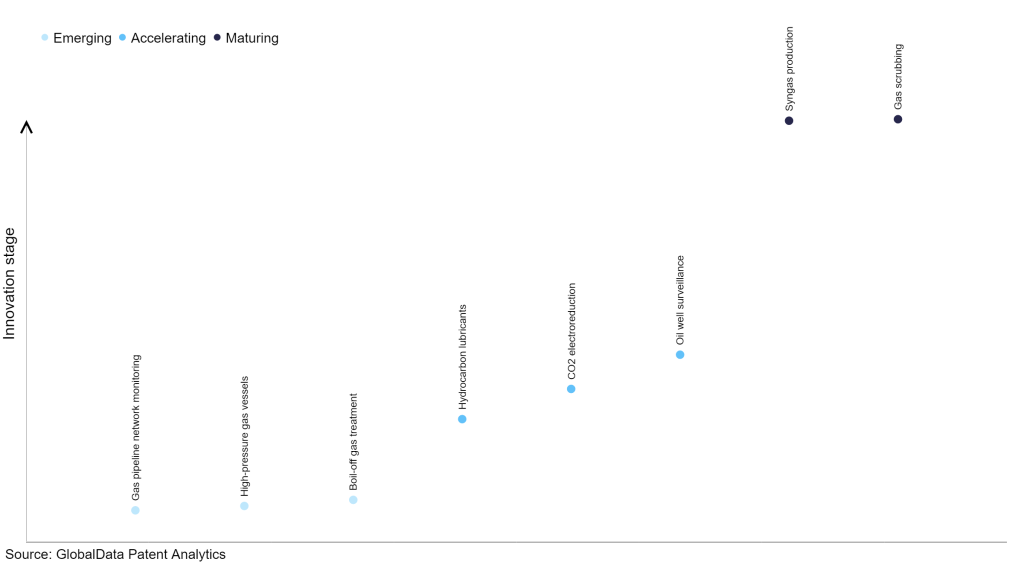The oil & gas industry continues to be a hotbed of patent innovation. Activity is driven by the need for more efficient drilling, safety enhancement, quality control, and cost and time reduction, and the growing importance of technologies such as artificial intelligence (AI), robotics, machine learning (ML), and big data. In the last three years alone, there have been over 327,000 patents filed and granted in the oil & gas industry, according to GlobalData’s report on Innovation in oil & gas: drilling tool wear estimation. Buy the report here.
However, not all innovations are equal and nor do they follow a constant upward trend. Instead, their evolution takes the form of an S-shaped curve that reflects their typical lifecycle from early emergence to accelerating adoption, before finally stabilizing and reaching maturity.
Identifying where a particular innovation is on this journey, especially those that are in the emerging and accelerating stages, is essential for understanding their current level of adoption and the likely future trajectory and impact they will have.
65+ innovations will shape the oil & gas industry
According to GlobalData’s Technology Foresights, which plots the S-curve for the oil & gas industry using innovation intensity models built on over 201,000 patents, there are 65+ innovation areas that will shape the future of the industry.
Within the emerging innovation stage, gas pipeline network monitoring, high-pressure gas vessels, and boil-off gas treatment are disruptive technologies that are in the early stages of application and should be tracked closely. Hydrocarbon lubricants, CO2 electroreduction and oil well surveillance are some of the accelerating innovation areas, where adoption has been steadily increasing. Among maturing innovation areas are syngas production and gas scrubbing, which are now well established in the industry.
Innovation S-curve for the oil & gas industry

Drilling tool wear estimation is a key innovation area in oil & gas
Drilling tool wear estimation refers to the process of predicting the condition of drill bits and other drilling tools used in mining or other drilling operations. Drilling companies can predict when a drill bit will wear out and needs to be replaced, by analyzing various factors such as the material being drilled, the drill bit design, and the drilling parameters.
GlobalData’s analysis also uncovers the companies at the forefront of each innovation area and assesses the potential reach and impact of their patenting activity across different applications and geographies. According to GlobalData, there are 110+ companies, spanning technology vendors, established oil & gas companies, and up-and-coming start-ups engaged in the development and application of drilling tool wear estimation.
Key players in drilling tool wear estimation – a disruptive innovation in the oil & gas industry
‘Application diversity’ measures the number of applications identified for each patent. It broadly splits companies into either ‘niche’ or ‘diversified’ innovators.
‘Geographic reach’ refers to the number of countries each patent is registered in. It reflects the breadth of geographic application intended, ranging from ‘global’ to ‘local’.
Patent volumes related to drilling tool wear estimation
Source: GlobalData Patent Analytics
Halliburton, Schlumberger, and Saudi Arabian Oil are some of the leading patent filers in drilling tool wear estimation. Halliburton provides the DS365.ai.cloud service, which operates on the OSDU Data Platform and utilizes the iEnergy Cloud architecture to enhance drilling and production activities in the subsurface. DS365.ai leverages industry-tailored AI and machine learning (ML) models to enhance operational efficiency and boost productivity. Some other key patent filers in the space include China Petrochemical, and Exxon Mobil.
In terms of application diversity, Halliburton leads the pack, while Schlumberger, and Saudi Arabian Oil stood in the second and third positions, respectively. By means of geographic reach, Ledaflow Technologies held the top position, followed by Groupe Industriel Marcel Dassault, Panasonic and BASF.
Oil and gas companies are increasingly using drilling tool wear estimation to optimize performance, decrease costs, and increase production.
To further understand the key themes and technologies disrupting the oil & gas industry, access GlobalData’s latest thematic research report on Oil & Gas.
Data Insights
From

The gold standard of business intelligence.
Blending expert knowledge with cutting-edge technology, GlobalData’s unrivalled proprietary data will enable you to decode what’s happening in your market. You can make better informed decisions and gain a future-proof advantage over your competitors.



